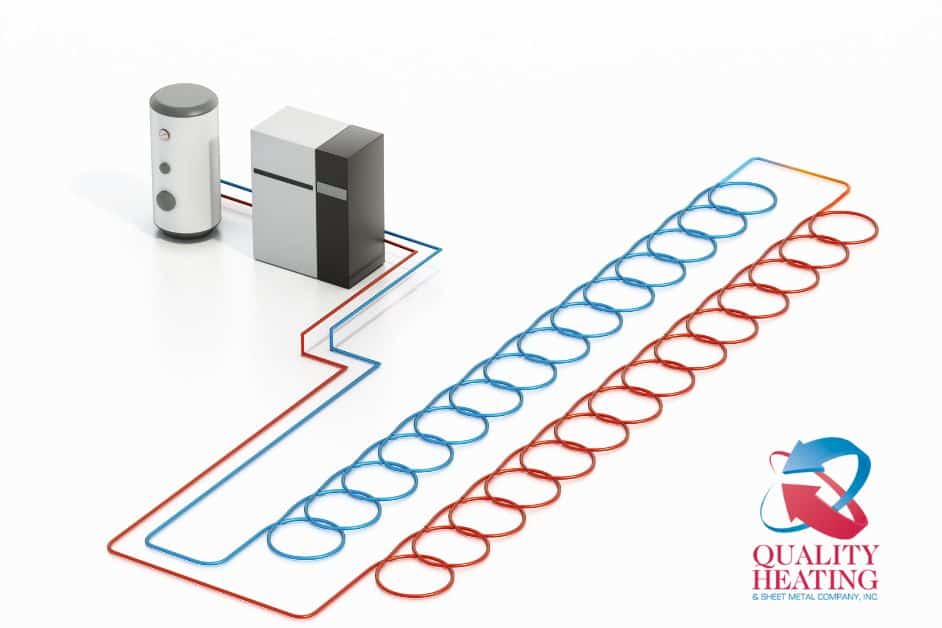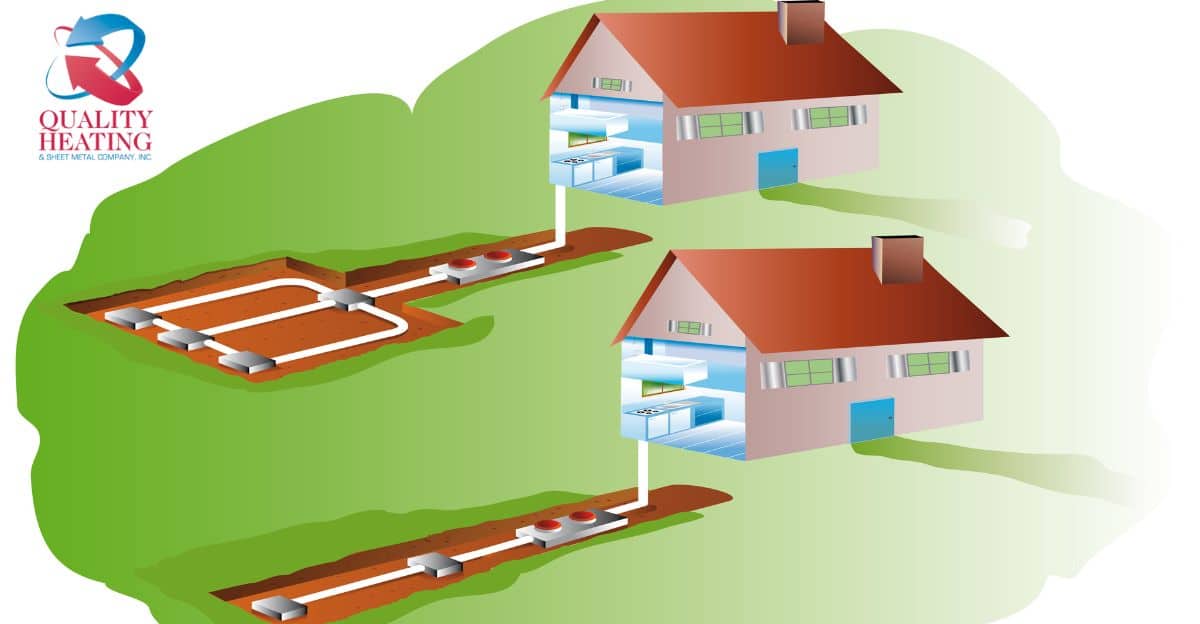Ground coil systems are popular as an eco-friendly and efficient solution for heating and cooling buildings. These complex networks of underground pipes play a crucial role in transferring heat between the earth’s constant temperature and your home, providing both heating and cooling sustainably and cost-effectively. However, misconceptions surrounding ground coil systems can deter homeowners from exploring the benefits of geothermal technology.
Continue reading to learn about the common misconceptions about ground coil systems and understand their functionality, benefits, and practical applications.
Understanding Ground Coil Systems
Ground coil systems use the stable temperature of the Earth’s crust to extract or deposit heat and provide heating, cooling, and hot water for residential, commercial, and institutional buildings. Ground coil systems consist of underground pipes, a heat pump unit, and a distribution system, working together to transfer heat between the building and the ground.
Dispelling Misconceptions
Understanding the proper terminology can help homeowners make informed decisions about using the power of geothermal energy in their homes. Here are the common misconceptions surrounding ground coil systems:
Effective Only in Warm Climates
The truth is that ground coil systems can efficiently heat and cool buildings in various climates, including colder regions with harsh winters. It is because ground coil systems tap into the relatively stable temperature of the Earth’s crust, which remains consistent year-round, regardless of external weather conditions.
Expensive and Unaffordable While it’s true that upfront installation costs may be higher than conventional HVAC systems, ground coil systems offer significant long-term savings on utility bills due to their lower operating costs. Additionally, various financial incentives, such as tax credits and rebates, help reduce the initial investment and make ground coil systems more accessible.
Noisy and Disruptive
There is a belief that ground coil systems produce noise and vibrations that can disturb building occupants. However, they operate quietly, with most of the equipment indoors. Unlike traditional air-source heat pumps, which rely on noisy outdoor condenser units, ground coil systems utilize the ground’s stable temperature for heat exchange, resulting in a quieter and more peaceful indoor environment.
Require Extensive Land for Installation
While horizontal ground loops require ample space, alternative configurations, such as vertical ground loops or pond/lake loops, can be implemented in properties with limited land area. Additionally, advancements in loop design and installation techniques have made ground coil systems more adaptable to various property sizes and layouts.
High Maintenance and Prone to Breakdowns
Contrary to popular belief, ground coil systems require minimal maintenance compared to traditional HVAC systems. Most of the system’s components are buried underground, protected from the elements, reducing exposure to wear and tear. Routine inspections and essential upkeep ensure ground coil systems provide reliable heating and cooling for many years without significant issues or breakdowns.

Poor Efficiency
Against popular belief, ground coil systems are remarkably efficient, boasting high coefficients of performance (COPs). COP measures the ratio of heat output to the amount of electricity input, indicating the system’s energy efficiency. Ground coil systems achieve COPs ranging from 3.0 to 5.0, producing three to five units of heat for every unit of electricity consumed. This efficiency surpasses traditional heating and cooling systems, leading to substantial energy savings over the system’s lifespan.
Environmental Impact
Some argue that ground coil systems have a bad environmental impact due to the energy required for their operation. However, these claims fail to acknowledge the system’s sustainability and minimal carbon footprint. Unlike fossil fuel-based heating and cooling systems, ground coil systems utilize renewable energy sources—geothermal heat—and emit no greenhouse gases during operation. Furthermore, the energy efficiency of ground coil systems reduces reliance on non-renewable resources and risks environmental pollution, making them a greener alternative for climate-conscious consumers.
Contaminate Groundwater
The closed-loop system used in ground coil systems ensures no groundwater contamination. The water-based solution circulating through the pipes is entirely separate from the groundwater. Additionally, non-toxic antifreeze solutions are often added to the water to prevent freezing in colder climates.
Don’t Fit Existing Homes
While geothermal systems are ideal for new construction, you can also use them for existing homes. The feasibility depends on factors like property size and existing ductwork. A qualified geothermal professional can assess your situation and determine if your home is suitable for a geothermal retrofit.
Choosing the Right System for Your Needs
With the misconceptions addressed, consider incorporating a ground coil system into your home. Here are some additional factors to consider:
- Property Size and Layout: Depending on your land area, you can choose horizontal and vertical loops. Consult with a qualified geothermal installer to determine the most suitable configuration for your property.
- Financial Incentives: You can research available tax credits and rebates in your region, which can reduce the upfront installation cost. Many government programs actively encourage the adoption of renewable energy solutions like geothermal systems.
- Climate and Heating/Cooling Needs: While ground coil systems operate efficiently across most climates, understanding your specific heating and cooling demands will help determine the optimal system size and design.
Steps to Consider
If you’re interested in harnessing the power of geothermal energy through a ground coil system, here’s how to get started:
- Research and Education: Learn more about geothermal technology and ground coil systems. Reliable sources like government websites and industry publications offer valuable information to empower informed decision-making.
- Seek Professional Guidance: Consult with qualified geothermal installers familiar with your region’s regulations and installation practices. Reputable installers can assess your property, recommend the most suitable system design, and provide accurate cost estimates.
- Compare Quotes: Obtain quotes from several qualified installers before making a decision. It allows you to compare pricing, system options, and the experience level of each company.
Ground coil systems represent a sustainable and efficient solution for meeting heating and cooling needs while reducing energy consumption and environmental impact. Using ground coil technology enhances comfort and affordability and contributes to a more sustainable future. However, consider approaching professionals in the field, like Quality Heating & Sheet Metal Company, Inc., to ensure you get the best assistance. Contact us today!




0 Comments